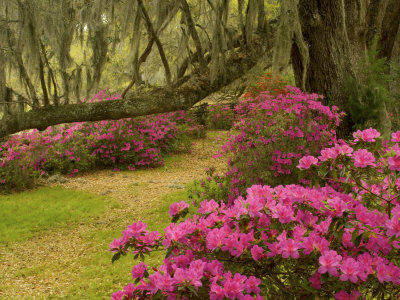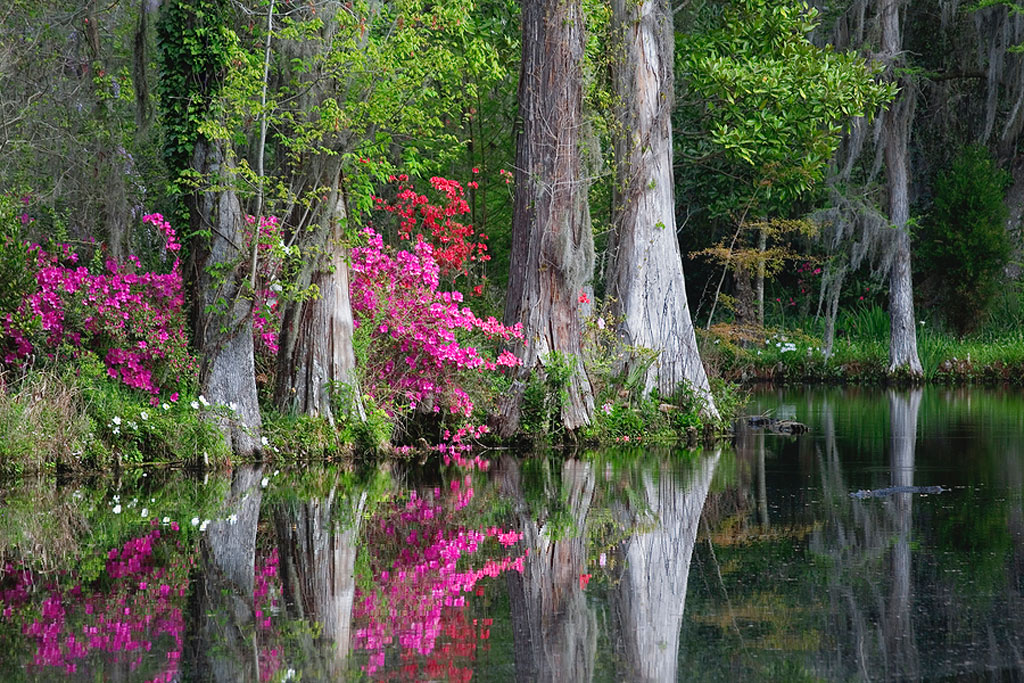
The Magnolia Plantation House, Charleston, South Carolina, U.S.A.
From The National Trust for Historic Preservation: Plantation and Gardens in Charleston, S.C., may be famous for its gardens, but it's also notable as one of the few places in America where black people have been living and working for more than three centuries. From 1679 until the 1990s, African Americans have been living in cabins there, tending Magnolia's grounds.
Now, for the first time ever, the five remaining cabins, built between 1850 and 1900, have been restored. On Feb. 28, the plantation will hold a grand opening, and tours of the new exhibit, called "From Slavery to Freedom," will begin the following day.
"It just seemed like the kind of thing whose time had come," says Taylor Nelson, whose family founded Magnolia Plantation in the 1600s. "What sparked the idea to actually [restore the cabins] is that I was working for a couple of years with my grandfather at Magnolia for a couple years, and he passed away. We thought it was an appropriate time to tell that story."
Nelson organized a luncheon last year with the descendants of slaves and freedmen who had lived in the cabins. "We all got together to talk about how their input could be taken into this project, and the lunch ended with everyone holding hands and singing 'Amazing Grace'."

Three of the five cabins had no foundations, and all had water and termite damage before the restoration. (Credit: Rock Creek Craftsmen)
The cabins "were in pretty bad shape. They were in danger of falling to pieces," says DJ Tucker, senior project contractor at The Living History Group, based in Charleston, the exhibit's designers. In January 2007, before the work began, archaeologists conducted a six-month survey of the area.
"We were just gobsmacked about the number of Colonial artifacts we were finding," Tucker says: a cup, a candlestick, a button from a British uniform sold to slaves, and pieces of Colono Ware, early pottery made by African slaves. "It was tremendous."

Last February, workers focused on the cabins. "Once we got past the [1980s] additions, we found the craftsmanship was excellent," says Kevin Meek, CEO of Charleston-based Rock Creek Craftsmen. "We recycled all the materials we could; preservation is the ultimate green."
The Living History Group restored each of the cabins to a different time period: an 1850 slave cabin, an 1870 freedmen's home, a 1900 gardener's home, a 1930 gardener's home, and the 1969 Civil rights-era home of the Leech Family, third-generation residents of Magnolia, who lived in the cabin without running water until the 1970s.

On a tour, visitors will listen to an interpreter highlight the cabins' histories as well as parts of the preservation project. Then they'll be able to wander through the structures, including the oldest cabin, where half of the two-family dwelling has been left unrestored as a time capsule.

The Magnolia Plantation and Garden's website offers this selection "From Slavery to Freedom: The Magnolia Cabin Project"
Magnolia's Cabin Project began more than four years ago in an effort to preserve five historic structures that date back to 1850. These former slave dwellings now serve as the focal point for an award-winning 45-minute program in African-American history.
Magnolia recognizes the importance of acknowledging the vital role that Gullah people and culture plays in any interpretation of Lowcountry history. By addressing this often overlooked part of the region's narrative, Magnolia seeks to respectfully afford credit where credit is due.

Visitors have the option to take a shuttle to the cabins, where they will experience an engaging and interactive discussion of the dynamic issues that shape this delicate inquiry. Afterward, time is given to allow everyone the opportunity to explore each cabin to appreciate the lengthy period in which the buildings were actively occupied - from the 1850s to the late-1990s. This arc of history conveys the tumultuous times continuously challenging African-American families from slavery, the Jim Crow/segregation era and through the modern Civil Rights period.
Magnolia promises visitors will leave with a newfound perspective rooted in cutting-edge historical and archaeological studies that consistently serve to inform and astonish all who visit.

Cabin A - Circa 1850's Slave Cabin
Built sometime in the early 1850's, this pine-framed duplex was designed to hold two separate families with as many as six people per room. Enslaved African-Americans lived here until Charleston fell to Union forces in February 1865.

Cabin B  - 1926 Gardener's Home
- 1926 Gardener's Home
 - 1926 Gardener's Home
- 1926 Gardener's HomeBuilt in the 1850's, this cabin was restored to reflect the mid 1920's era when it was the home of one of Magnolia's gardeners. The Hastie family often brought newspapers with them from Charleston and New York, which were used for cabin insulation and are recreated here.

Cabin C - 1969 Leach Family Home
Also erected in the 1850's, this cabin was later inhabited by free African-Americans working at Magnolia. The Leach family boasted a long lineage of prestigious gardeners dating back to the early 1930's, and Johnnie Leach resided here from 1946 until 1969.

Cabin D - 1870 Freedmen's House
African-American workers resided in this cabin off and on into the 1980's, making extensive alterations over the years. Magnolia Plantation restored this 1850's structure to its 1870's condition to illustrate a time when many former slaves became gardeners, porters and guides to the many visitors who traveled to Charleston aboard steamboats once tourism began its rise after the Civil War.

Cabin E - Circa 1900 Gardener's Home
This is the only cabin on this street not built during slavery. All indicators point to the building's completion occurring around 1900, and would have provided shelter for an individual or couple without children. The last person to inhabit this cabin was groundskeeper Allen Hinge, who left in 1999. (source: Magnolia Plantation & Gardens)

Thanks for your good Post
ReplyDeletehttp://www.livestreamsportshd.com/
I visit the plantation with my family .
ReplyDelete